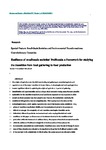Resilience of small-scale societies’ livelihoods: a framework for studying the transition from food gathering to food production
| dc.contributor.author | Lancelotti, C | |
| dc.contributor.author | Zurro, D | |
| dc.contributor.author | Whitehouse, NJ | |
| dc.contributor.author | Madella, M | |
| dc.contributor.author | Kramer, K | |
| dc.contributor.author | García-Granero, JJ | |
| dc.contributor.author | Greaves, R | |
| dc.date.accessioned | 2016-07-22T11:31:24Z | |
| dc.date.accessioned | 2016-10-13T21:16:40Z | |
| dc.date.accessioned | 2016-11-09T18:06:44Z | |
| dc.date.available | 2016-07-22T11:31:24Z | |
| dc.date.available | 2016-10-13T21:16:40Z | |
| dc.date.available | 2016-11-09T18:06:44Z | |
| dc.date.issued | 2016-09-01 | |
| dc.identifier.issn | 1708-3087 | |
| dc.identifier.issn | 1708-3087 | |
| dc.identifier.other | art8 | |
| dc.identifier.uri | http://hdl.handle.net/10026.1/6696 | |
| dc.description.abstract |
The origins of agriculture and the shift from hunting and gathering to committed agriculture is regarded as one of the major transitions in human history. Archeologists and anthropologists have invested significant efforts in explaining the origins of agriculture. A period of gathering intensification and experimentation and pursuing a mixed economic strategy seems the most plausible explanation for the transition to agriculture and provides an approach to study a process in which several nonlinear processes may have played a role. However, the mechanisms underlying the transition to full agriculture are not completely clear. This is partly due to the nature of the archeological record, which registers a practice only once it has become clearly established. Thus, points of transitions have limited visibility and the mechanisms involved in the process are difficult to untangle. The complexity of such transitions also implies that shifts can be distinctively different in particular environments and under varying historical and social conditions. In this paper we discuss some of the elements involved in the transition to food production within the framework of resilience theory. We propose a theoretical conceptual model in which the resilience of livelihood strategies lies at the intersection of three spheres: the environmental, economical, and social domains. Transitions occur when the rate of change, in one or more of these domains, is so elevated or its magnitude so large that the livelihood system is unable to bounce back to its original state. In this situation, the system moves to an alternative stable state, from one livelihood strategy to another. | |
| dc.language | en | |
| dc.language.iso | en | |
| dc.publisher | Resilience Alliance, Inc. | |
| dc.relation.replaces | http://hdl.handle.net/10026.1/5099 | |
| dc.relation.replaces | 10026.1/5099 | |
| dc.relation.replaces | http://hdl.handle.net/10026.1/6526 | |
| dc.relation.replaces | 10026.1/6526 | |
| dc.subject | ABM | |
| dc.subject | resources | |
| dc.subject | social-ecological dynamics | |
| dc.subject | subsistence strategies | |
| dc.subject | transition to agriculture | |
| dc.title | Resilience of small-scale societies’ livelihoods: a framework for studying the transition from food gathering to food production | |
| dc.type | journal-article | |
| dc.type | Article | |
| plymouth.edition | Pending | |
| plymouth.issue | 4 | |
| plymouth.volume | 21(4): 8 | |
| plymouth.publication-status | Published online | |
| plymouth.journal | Ecology and Society | |
| dc.identifier.doi | 10.5751/ES-08757-210408 | |
| plymouth.organisational-group | /Plymouth | |
| plymouth.organisational-group | /Plymouth/Faculty of Science and Engineering | |
| plymouth.organisational-group | /Plymouth/REF 2021 Researchers by UoA | |
| plymouth.organisational-group | /Plymouth/REF 2021 Researchers by UoA/UoA14 Geography and Environmental Studies | |
| dcterms.dateAccepted | 2016-07-31 | |
| dc.identifier.eissn | 1708-3087 | |
| dc.rights.embargoperiod | Not known | |
| rioxxterms.versionofrecord | 10.5751/ES-08757-210408 | |
| rioxxterms.licenseref.uri | http://www.rioxx.net/licenses/all-rights-reserved | |
| rioxxterms.licenseref.startdate | 2016-09-01 | |
| rioxxterms.type | Journal Article/Review |




